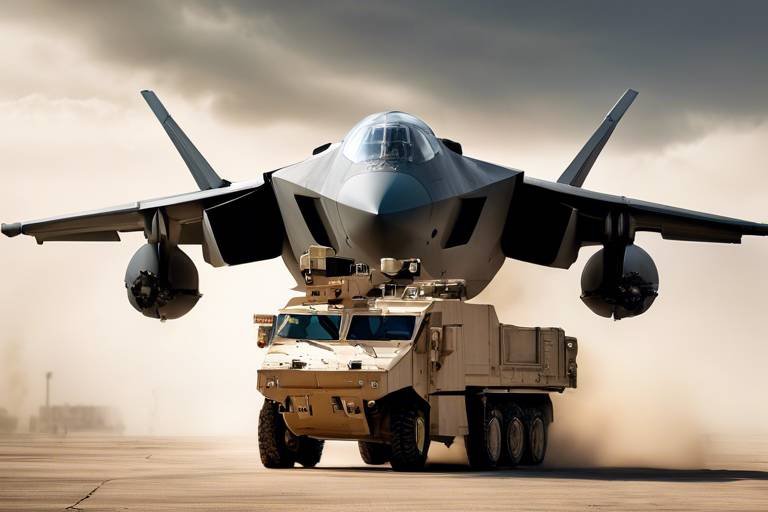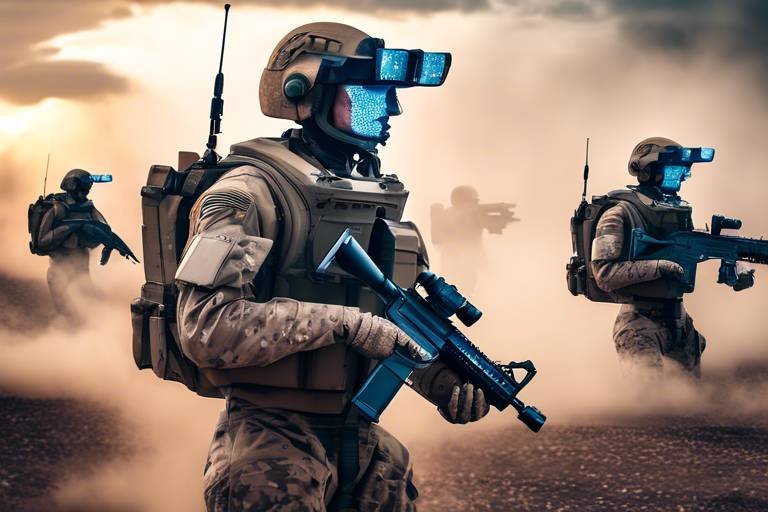Autonomous Military Convoys - Enhancing Supply Chain Efficiency
In the rapidly evolving landscape of modern warfare, autonomous military convoys are emerging as a game-changer in logistics and supply chain management. Imagine a convoy of vehicles, seamlessly navigating through rugged terrains and hostile environments, all without a single human driver. This revolutionary approach not only enhances operational efficiency but also significantly reduces the risks faced by military personnel. As we delve deeper into the world of autonomous military convoys, we’ll explore how they are reshaping the logistics of armed forces, making them more responsive and adaptable to the challenges of contemporary warfare.
Autonomous military convoys represent a significant advancement in military logistics, utilizing cutting-edge technology to transport supplies and equipment with minimal human intervention. These convoys leverage a combination of artificial intelligence (AI), global positioning systems (GPS), and advanced sensor technologies to navigate complex environments. The result? Enhanced operational efficiency and safety. By automating the transportation of goods, military forces can focus their human resources on more critical tasks, allowing for a more streamlined approach to logistics.
The deployment of autonomous convoys offers numerous benefits that can transform military operations. One of the most notable advantages is the reduction in manpower costs. By minimizing the need for human drivers, military organizations can allocate their resources more effectively, leading to substantial savings in operational costs. Moreover, these convoys improve supply chain reliability, ensuring that critical supplies reach their destinations on time, regardless of external conditions.
In addition to cost efficiency, autonomous convoys enhance mission effectiveness. With the ability to operate continuously without the need for rest, these vehicles can extend the operational reach of supply chains. This capability is particularly crucial in combat scenarios where timely delivery of resources can make a significant difference between success and failure.
Cost efficiency is at the forefront of the benefits provided by autonomous military convoys. By cutting down on operational costs associated with personnel, fuel consumption, and maintenance, military logistics can become more sustainable. For instance, the table below illustrates the potential cost savings associated with the implementation of autonomous convoys:
| Cost Category | Traditional Convoy Costs | Autonomous Convoy Costs | Estimated Savings |
|---|---|---|---|
| Personnel Expenses | $500,000 | $200,000 | $300,000 |
| Fuel Consumption | $300,000 | $150,000 | $150,000 |
| Maintenance | $100,000 | $50,000 | $50,000 |
| Total Estimated Savings | $900,000 | $400,000 | $500,000 |
One of the most compelling reasons to adopt autonomous military convoys is the reduction of risks to personnel. In traditional logistics operations, human drivers are often exposed to dangerous situations, particularly when traversing conflict zones. With autonomous systems, the need for human presence in high-risk areas is significantly diminished, allowing for safer transportation of supplies. This shift not only protects lives but also enhances overall mission integrity.
Another advantage of autonomous convoys is their ability to operate continuously without the need for rest. This capability allows for an increased operational reach, ensuring that critical resources are delivered to frontline units in a timely manner. Imagine a convoy that can travel day and night, navigating through treacherous terrains, all while maintaining a steady pace. This level of efficiency can be a game-changer in military logistics.
The integration of advanced technologies is essential for the successful operation of autonomous military convoys. AI plays a crucial role in enabling real-time navigation and obstacle avoidance, while GPS ensures accurate positioning. The combination of these technologies allows for seamless communication between vehicles, creating a network of autonomous units that can adapt to changing environments.
Despite their advantages, the adoption of autonomous military convoys is not without challenges. Technological limitations, regulatory hurdles, and the need for robust cybersecurity measures pose significant obstacles to implementation. Addressing these challenges is crucial for the successful integration of autonomous systems into military logistics.
As autonomous systems rely heavily on data and communication networks, ensuring robust cybersecurity is paramount. The risk of hacking and unauthorized access could compromise mission integrity, making it essential to implement stringent security measures to protect sensitive military data.
The deployment of autonomous military vehicles raises important regulatory and ethical questions. Who is accountable when an autonomous vehicle makes a mistake? What are the implications for decision-making in combat situations? Compliance with international laws of warfare must also be considered, making it essential for military organizations to navigate these complex issues carefully.
The future of military logistics looks promising with the continued evolution of autonomous technology. As these systems become more sophisticated, they have the potential to revolutionize the way armed forces manage supply chains and conduct operations in diverse environments. The integration of autonomous military convoys could lead to a more agile and responsive military, capable of adapting to the ever-changing landscape of warfare.
- What are autonomous military convoys? Autonomous military convoys are vehicle fleets that operate without human drivers, utilizing advanced technologies for navigation and logistics.
- How do autonomous convoys improve military logistics? They enhance efficiency, reduce costs, and minimize risks to personnel while ensuring timely delivery of supplies.
- What challenges do autonomous convoys face? Key challenges include technological limitations, cybersecurity concerns, and regulatory and ethical issues.
- What is the future of autonomous military logistics? The future is promising, with advancements in technology likely to revolutionize military supply chains and operations.

Introduction to Autonomous Military Convoys
In the ever-evolving landscape of modern warfare, the introduction of autonomous military convoys marks a revolutionary shift in military logistics. Imagine a convoy of vehicles, seamlessly navigating treacherous terrains and hostile environments, all while requiring minimal human intervention. This is not a scene from a futuristic movie; it is becoming a reality thanks to cutting-edge technologies. Autonomous military convoys utilize advanced systems such as artificial intelligence (AI), GPS, and sophisticated sensors to transport vital supplies and equipment efficiently and safely.
The primary goal of these convoys is to enhance operational efficiency while simultaneously reducing risks associated with human drivers. Picture a scenario where military personnel are no longer exposed to the dangers of transporting supplies through conflict zones. Instead, autonomous vehicles take on the brunt of this responsibility, allowing human soldiers to focus on critical combat tasks. This shift not only saves lives but also optimizes the logistics chain, ensuring that resources are delivered to the front lines without delay.
Moreover, the use of autonomous convoys can significantly improve the reliability of supply chains. In traditional logistics, human error can lead to delays, miscommunication, or even accidents. However, with autonomous systems, these risks are minimized. The vehicles are equipped with real-time navigation capabilities and obstacle avoidance technology, allowing them to adapt to changing environments and unexpected challenges. This level of adaptability is crucial in military operations, where every second counts.
As we delve deeper into the world of autonomous military convoys, it is essential to understand the technological innovations that make this possible. The integration of AI allows these vehicles to learn from their surroundings, making them smarter and more efficient over time. Additionally, the use of sensor systems enables them to detect obstacles, monitor road conditions, and communicate with other vehicles in the convoy, creating a cohesive unit that operates like a well-oiled machine.
However, while the potential benefits are enormous, it is crucial to recognize the challenges that accompany the implementation of autonomous military convoys. From cybersecurity threats to regulatory and ethical considerations, the journey towards fully autonomous military logistics is fraught with complexities. Nevertheless, the promise of enhanced supply chain efficiency and reduced risks makes this an exciting frontier in military operations.
- What are autonomous military convoys? Autonomous military convoys are self-driving vehicles that transport supplies and equipment with minimal human intervention, enhancing safety and efficiency in military logistics.
- How do autonomous convoys improve supply chain efficiency? They reduce human error, minimize personnel risks, and can operate continuously without rest, ensuring timely delivery of resources.
- What technologies are used in autonomous military convoys? Key technologies include AI, GPS, and advanced sensor systems that enable real-time navigation and obstacle avoidance.
- What challenges do autonomous military convoys face? Challenges include cybersecurity risks, regulatory hurdles, and ethical questions regarding accountability in combat situations.

Benefits of Autonomous Convoys
The deployment of autonomous military convoys is reshaping the logistics landscape in modern warfare, offering a myriad of benefits that enhance operational efficiency. Imagine a convoy of vehicles, traveling together without the need for human drivers, navigating complex terrains and unpredictable environments. This is not just a futuristic dream; it’s a reality that is revolutionizing how military operations are conducted. One of the standout advantages is the significant reduction in manpower costs. By minimizing the need for human drivers, military forces can allocate their personnel to more critical roles, optimizing their resources and enhancing overall mission effectiveness.
Moreover, the reliability of supply chains is markedly improved with autonomous convoys. These systems are designed to operate in a synchronized manner, meaning they can communicate with each other in real-time. This capability reduces the chances of delays and ensures that supplies reach their destinations on time. For instance, in a scenario where troops are engaged in combat, having a reliable supply chain can mean the difference between success and failure. Autonomous convoys can adapt to changing conditions, rerouting themselves to avoid obstacles or threats, which is a game-changer for military operations.
In addition to cost savings and reliability, another compelling benefit is the reduction of personnel risks. In traditional logistics operations, human drivers are often exposed to dangerous situations, especially when traversing conflict zones. Autonomous systems mitigate this risk by taking on these hazardous tasks, allowing military personnel to remain at a safe distance. This not only protects lives but also enhances the overall safety of operations. The ability of autonomous vehicles to operate in high-risk areas without putting human lives at stake is a significant leap forward in military logistics.
Furthermore, the increased operational reach of these convoys is noteworthy. Unlike human drivers who require rest and breaks, autonomous vehicles can operate continuously. This capability means that supplies can be delivered more swiftly and efficiently, ensuring that frontline units receive the necessary resources without delay. Imagine the strategic advantage of having a constant flow of supplies, ammunition, and medical resources reaching troops in the field without interruption. This can drastically alter the dynamics of military engagements, providing a crucial edge over adversaries.
To summarize, the benefits of autonomous military convoys are manifold, encompassing cost efficiency, improved reliability, enhanced safety, and extended operational reach. As these technologies continue to evolve, they promise to redefine how military logistics are managed, making operations not only more effective but also safer for those who serve on the front lines.
- What are autonomous military convoys? Autonomous military convoys are self-driving vehicles that transport supplies and equipment with minimal human intervention.
- How do autonomous convoys improve logistics? They enhance logistics by reducing manpower costs, increasing supply chain reliability, and decreasing the risks to personnel.
- What technologies are used in autonomous convoys? Technologies such as AI, GPS, and advanced sensor systems are integrated to enable real-time navigation and obstacle avoidance.
- What are the safety benefits of using autonomous convoys? They minimize the exposure of military personnel to dangerous situations, especially in conflict zones, thereby reducing the risk of casualties.

Cost Efficiency
When it comes to military logistics, is a game-changer, and autonomous military convoys are at the forefront of this revolution. Imagine a battlefield where resources are delivered with pinpoint accuracy and minimal financial burden. By minimizing the need for human drivers, these convoys can significantly cut operational costs across various dimensions. For instance, personnel expenses are slashed as fewer soldiers are required for driving duties. This not only saves money but also allows military personnel to focus on more critical tasks, enhancing overall mission effectiveness.
Moreover, the reduction in fuel consumption is another crucial aspect. Autonomous vehicles can be programmed to drive in the most efficient manner possible, optimizing fuel usage and reducing the carbon footprint of military operations. This is particularly important in an era where sustainability is becoming increasingly vital, even in defense. In fact, studies suggest that autonomous convoys can save up to 30% in fuel costs compared to traditional convoys. This leads to a more sustainable military logistics framework, allowing for better resource allocation.
Maintenance costs are also dramatically reduced with the implementation of autonomous technology. Traditional vehicles, subjected to wear and tear from constant human operation, often require frequent repairs and servicing. However, autonomous systems are designed with advanced diagnostics that can predict and alert maintenance needs before they become critical. This proactive approach not only saves money but also ensures that the convoys remain operational and reliable.
| Cost Factors | Traditional Convoys | Autonomous Convoys |
|---|---|---|
| Personnel Expenses | $100,000 | $30,000 |
| Fuel Costs | $50,000 | $35,000 |
| Maintenance Costs | $20,000 | $10,000 |
| Total Estimated Cost | $170,000 | $75,000 |
In summary, the financial benefits of autonomous military convoys are substantial. They not only reduce costs related to personnel, fuel, and maintenance but also pave the way for more efficient resource management in military operations. As we look to the future, the question becomes not if, but when these autonomous systems will become the standard in military logistics.
- What are autonomous military convoys?
Autonomous military convoys are self-driving vehicles designed to transport supplies and equipment without human intervention. - How do autonomous convoys improve cost efficiency?
They reduce personnel, fuel, and maintenance costs, leading to significant savings in military logistics. - What technologies are used in autonomous convoys?
Technologies like AI, GPS, and advanced sensors are integrated to enable navigation and obstacle avoidance. - What challenges do autonomous convoys face?
Challenges include cybersecurity risks, regulatory hurdles, and ethical considerations regarding their use in combat.

Reduced Personnel Risks
One of the most compelling advantages of autonomous military convoys is their ability to significantly reduce personnel risks. Imagine a scenario where military supply chains are constantly under threat from enemy attacks, ambushes, or improvised explosive devices (IEDs). In such high-stakes environments, the safety of human drivers becomes a paramount concern. By deploying autonomous vehicles, the military can effectively minimize the number of personnel exposed to these dangers.
These autonomous systems are designed to navigate through hazardous terrains and conflict zones without the need for human intervention. This not only keeps soldiers out of harm's way but also allows them to focus on more strategic tasks that require human judgment and decision-making. The technology behind these convoys includes advanced sensors, AI algorithms, and real-time data processing capabilities that enable them to detect and respond to threats autonomously.
Furthermore, the ability of these convoys to operate in dangerous areas without risking human lives can lead to a more efficient logistics operation. For instance, when supplies are needed urgently in a combat zone, autonomous vehicles can deliver them without the delays associated with crewed transport. This can be crucial for maintaining operational momentum, especially in fast-paced military engagements.
To illustrate the potential impact of reduced personnel risks, consider the following table that outlines the differences between traditional supply convoys and autonomous military convoys:
| Aspect | Traditional Supply Convoys | Autonomous Military Convoys |
|---|---|---|
| Personnel Exposure | High risk of casualties | No personnel on board |
| Operational Flexibility | Dependent on crew schedules | Operates continuously without rest |
| Response to Threats | Human decision-making required | Real-time autonomous threat assessment |
| Cost Implications | Higher personnel costs | Lower operational costs |
In summary, the deployment of autonomous military convoys represents a revolutionary shift in military logistics, particularly in terms of reducing personnel risks. As technology continues to evolve, we can expect even greater advancements that will further safeguard our military personnel while enhancing operational efficiency.
- What are autonomous military convoys?
Autonomous military convoys are self-operating vehicles designed to transport supplies and equipment without the need for human drivers, utilizing advanced technologies for navigation and obstacle avoidance. - How do autonomous convoys enhance safety?
They reduce the exposure of military personnel to dangerous situations, allowing for safer transport through conflict zones. - What technologies are used in autonomous convoys?
These vehicles typically integrate AI, GPS, and various sensor systems to facilitate real-time navigation and threat detection. - What challenges do autonomous military convoys face?
Challenges include technological limitations, cybersecurity concerns, and regulatory and ethical issues related to their deployment.

Increased Operational Reach
The advent of autonomous military convoys is akin to opening a new chapter in the saga of military logistics. Imagine a convoy that can travel tirelessly, day and night, without the need for rest breaks or sleep. This remarkable capability allows military forces to extend their operational reach significantly. With autonomous convoys, logistics can operate on a continuous cycle, ensuring that supplies and resources are delivered precisely when and where they are needed, even in the most challenging environments. This is not just about convenience; it’s about strategic advantage.
Consider a scenario where a frontline unit is engaged in a prolonged operation. Traditional supply chains often struggle to keep pace, leading to delays and potential shortages. However, with autonomous convoys, the logistics framework becomes a well-oiled machine, capable of adapting to real-time demands. These convoys can navigate through rough terrains, adverse weather conditions, and even hostile territories without the limitations faced by human drivers. This capability not only ensures that troops are well-supplied but also enhances their operational effectiveness and morale.
Moreover, the ability to operate continuously means that autonomous convoys can cover vast distances without the typical constraints of human fatigue. This characteristic allows military planners to rethink their strategies, as they can now rely on a logistics backbone that is both resilient and responsive. The integration of advanced technologies, such as AI-driven route optimization, further amplifies this effect, allowing convoys to choose the safest and most efficient paths to their destinations.
In essence, the increased operational reach provided by autonomous military convoys transforms the logistics landscape. It not only enhances supply chain efficiency but also supports the overall mission objectives of military forces. The ability to maintain a steady flow of supplies can be the difference between success and failure in military operations, making autonomous convoys an invaluable asset. As we look to the future, it’s clear that these innovations will play a pivotal role in shaping the battlefield dynamics of tomorrow.
- What are autonomous military convoys?
Autonomous military convoys are self-driving vehicles designed to transport supplies and equipment with minimal human intervention, enhancing logistical efficiency and safety. - How do autonomous convoys improve operational efficiency?
They operate continuously without the need for rest, allowing for timely delivery of resources and reducing delays typically associated with human drivers. - What technologies are used in autonomous military convoys?
Technologies such as AI, GPS, and advanced sensor systems are integrated to enable real-time navigation and obstacle avoidance. - Are there risks associated with autonomous military convoys?
Yes, challenges include cybersecurity threats, regulatory hurdles, and ethical concerns regarding accountability in combat situations.

Technological Innovations
This article explores the role of autonomous military convoys in modern warfare, focusing on their potential to improve logistics, reduce human risk, and enhance operational efficiency in supply chain management.
Autonomous military convoys represent a significant advancement in military logistics, utilizing cutting-edge technology to transport supplies and equipment with minimal human intervention, thereby enhancing operational efficiency and safety.
The deployment of autonomous convoys offers numerous benefits, including reduced manpower costs, improved supply chain reliability, and enhanced mission effectiveness, allowing military forces to operate more efficiently in various environments.
By minimizing the need for human drivers, autonomous convoys can significantly cut operational costs, including personnel expenses, fuel consumption, and maintenance, leading to more sustainable military logistics.
Autonomous systems decrease the exposure of military personnel to dangerous situations, allowing for safer transportation of supplies through conflict zones and reducing the risk of casualties.
With the ability to operate continuously without the need for rest, autonomous convoys can extend the operational reach of supply chains, ensuring timely delivery of critical resources to frontline units.
The integration of advanced technologies is vital for the successful operation of autonomous military convoys. These technologies include Artificial Intelligence (AI), Global Positioning Systems (GPS), and sophisticated sensor systems. Each of these innovations plays a crucial role in enhancing the operational capabilities of these convoys.
AI algorithms enable autonomous vehicles to learn from their environment and make real-time decisions. This means that they can adapt to changing conditions, such as unexpected obstacles or shifting weather patterns, which is essential for maintaining a reliable supply chain. For example, if an autonomous convoy encounters a roadblock, AI can analyze alternative routes and reroute the convoy efficiently.
GPS technology is another cornerstone of autonomous military logistics. It provides precise location data, enabling convoys to navigate accurately even in challenging terrains. When combined with sensor systems, GPS allows vehicles to maintain safe distances from each other, enhancing convoy safety and efficiency. These sensors can detect nearby vehicles, pedestrians, and other potential hazards, ensuring that the convoy can react swiftly to any threats.
Furthermore, the use of communication networks among vehicles in a convoy is critical. This technology allows for the sharing of vital information, such as speed, location, and any detected obstacles. Such real-time communication not only improves the convoy's efficiency but also enhances overall mission effectiveness.
| Technology | Function | Benefit |
|---|---|---|
| Artificial Intelligence (AI) | Real-time decision-making | Adapts to changing conditions |
| Global Positioning Systems (GPS) | Accurate navigation | Ensures precise location tracking |
| Sensor Systems | Obstacle detection | Enhances safety and efficiency |
| Communication Networks | Information sharing among vehicles | Improves mission coordination |
In conclusion, the technological innovations behind autonomous military convoys are not merely enhancements; they are transformative elements that redefine how military logistics operate. As these technologies continue to evolve, we can expect even greater efficiencies and capabilities in supply chain management, ultimately leading to improved outcomes in military operations.
Despite their advantages, the adoption of autonomous military convoys faces challenges, including technological limitations, regulatory hurdles, and the need for robust cybersecurity measures to protect sensitive military data.
As autonomous systems rely heavily on data and communication networks, ensuring robust cybersecurity is crucial to prevent hacking and unauthorized access, which could compromise mission integrity.
The deployment of autonomous military vehicles raises important regulatory and ethical questions regarding accountability, decision-making in combat situations, and compliance with international laws of warfare.
The future of military logistics looks promising with the continued evolution of autonomous technology, potentially revolutionizing the way armed forces manage supply chains and conduct operations in diverse environments.
- What are autonomous military convoys? Autonomous military convoys are self-driving vehicles that transport supplies and equipment with minimal human intervention.
- How do autonomous convoys improve safety? They reduce the exposure of military personnel to dangerous situations, minimizing the risk of casualties.
- What technologies are used in autonomous military convoys? Key technologies include AI, GPS, sensor systems, and communication networks.
- What are the main challenges in implementing autonomous convoys? Challenges include technological limitations, regulatory hurdles, and cybersecurity concerns.

Challenges in Implementation
While the potential of autonomous military convoys is indeed exciting, the path to their widespread adoption is fraught with challenges that need to be addressed. One of the most pressing issues is the technological limitations that currently exist. Although advancements in AI, GPS, and sensor technology have made significant strides, there are still obstacles to overcome. For instance, ensuring that these vehicles can navigate complex terrains and unpredictable environments without human intervention remains a formidable task. Imagine a convoy navigating through a war-torn city, dodging debris and adapting to sudden changes in the landscape—this requires a level of sophistication that is still in development.
Moreover, the integration of robust cybersecurity measures is crucial. As these autonomous systems rely heavily on data and communication networks, they become prime targets for cyberattacks. A successful breach could not only jeopardize sensitive military operations but could also lead to catastrophic consequences on the battlefield. Protecting against such threats requires a multi-layered approach, including encryption, real-time monitoring, and regular updates to software systems. The stakes are high, and the military must invest significantly in these protective measures to safeguard their operations.
Another significant challenge is the regulatory and ethical issues surrounding the deployment of autonomous vehicles. Questions about accountability arise when machines make decisions that could result in life or death situations. Who is responsible if an autonomous convoy makes a mistake? Is it the manufacturer, the military, or the software developer? These questions are not just theoretical; they demand real answers that align with international laws of warfare. The military must navigate these murky waters carefully, ensuring that they comply with regulations while also advancing their technological capabilities.
Furthermore, the cultural resistance within military organizations can pose a barrier. Traditionalists may be hesitant to embrace technology that replaces human roles, fearing loss of jobs or the human touch in operations. This resistance can slow down the implementation process and hinder the integration of autonomous systems. To overcome this, there needs to be a concerted effort to educate personnel on the benefits of these technologies, emphasizing that they are tools designed to enhance, not replace, human capabilities.
Lastly, the logistics of implementing a fleet of autonomous vehicles are complex. It requires a comprehensive strategy that includes training personnel, establishing maintenance protocols, and integrating these vehicles into existing supply chain frameworks. This transition is not just about introducing new technology; it's about rethinking and redesigning entire logistics operations to accommodate these advancements. The military must be prepared to invest time, resources, and effort into this transformation.
- What are autonomous military convoys? Autonomous military convoys are self-driving vehicles designed to transport supplies and equipment with minimal human oversight.
- What are the main benefits of using autonomous convoys? They offer cost savings, reduced personnel risks, and increased operational reach, allowing for more efficient logistics.
- What challenges do autonomous convoys face? Key challenges include technological limitations, cybersecurity risks, regulatory and ethical issues, cultural resistance, and logistical complexities.
- How can cybersecurity be ensured for autonomous systems? Implementing encryption, real-time monitoring, and regular software updates are essential to protect against cyber threats.
- What is the future of autonomous military logistics? The future looks promising, with continuous advancements in technology likely to revolutionize military supply chain management.

Cybersecurity Concerns
This article explores the role of autonomous military convoys in modern warfare, focusing on their potential to improve logistics, reduce human risk, and enhance operational efficiency in supply chain management.
Autonomous military convoys represent a significant advancement in military logistics, utilizing cutting-edge technology to transport supplies and equipment with minimal human intervention, thereby enhancing operational efficiency and safety.
The deployment of autonomous convoys offers numerous benefits, including reduced manpower costs, improved supply chain reliability, and enhanced mission effectiveness, allowing military forces to operate more efficiently in various environments.
By minimizing the need for human drivers, autonomous convoys can significantly cut operational costs, including personnel expenses, fuel consumption, and maintenance, leading to more sustainable military logistics.
Autonomous systems decrease the exposure of military personnel to dangerous situations, allowing for safer transportation of supplies through conflict zones and reducing the risk of casualties.
With the ability to operate continuously without the need for rest, autonomous convoys can extend the operational reach of supply chains, ensuring timely delivery of critical resources to frontline units.
The integration of advanced technologies such as AI, GPS, and sensor systems is essential for the successful operation of autonomous military convoys, enabling real-time navigation and obstacle avoidance.
Despite their advantages, the adoption of autonomous military convoys faces challenges, including technological limitations, regulatory hurdles, and the need for robust cybersecurity measures to protect sensitive military data.
As autonomous systems rely heavily on data and communication networks, ensuring robust cybersecurity is crucial to prevent hacking and unauthorized access, which could compromise mission integrity. Imagine a scenario where an adversary gains control of an autonomous convoy; the implications could be catastrophic. The potential for data breaches could expose operational plans and troop movements, putting lives at risk.
To combat these threats, military organizations must implement a multi-layered cybersecurity strategy. This includes:
- Encryption: Ensuring that all data transmitted between vehicles and command centers is encrypted to prevent interception.
- Intrusion Detection Systems: Utilizing advanced systems that can detect and respond to unauthorized access attempts in real-time.
- Regular Software Updates: Keeping software up to date to protect against known vulnerabilities and emerging threats.
Moreover, training personnel in cybersecurity awareness is essential. Just as soldiers are trained for combat, they must also be equipped with the knowledge to recognize and respond to cybersecurity threats. This holistic approach ensures that both technology and personnel are prepared to face the challenges of modern warfare.
The future of military logistics looks promising with the continued evolution of autonomous technology, potentially revolutionizing the way armed forces manage supply chains and conduct operations in diverse environments.
- What are autonomous military convoys?
Autonomous military convoys are self-operating vehicles that transport supplies and equipment with minimal human intervention, enhancing logistics and safety.
- How do autonomous convoys improve efficiency?
They reduce the need for human drivers, cut costs, and can operate continuously, ensuring timely delivery of resources.
- What cybersecurity measures are needed for autonomous convoys?
Key measures include data encryption, intrusion detection systems, regular software updates, and personnel training in cybersecurity awareness.
- What are the risks associated with autonomous military systems?
The main risks include potential hacking incidents, data breaches, and ethical concerns regarding decision-making in combat scenarios.

Regulatory and Ethical Issues
The deployment of autonomous military convoys is not just a matter of technological advancement; it also brings forth a myriad of regulatory and ethical challenges that must be addressed. As these autonomous systems become more prevalent on the battlefield, questions surrounding accountability and decision-making processes arise. Who is responsible when an autonomous vehicle makes a mistake? Is it the manufacturer, the military personnel overseeing the operation, or the software developers? These questions are not merely academic; they have profound implications for military operations and international relations.
Furthermore, the use of autonomous systems in combat situations raises ethical dilemmas. For instance, can we trust an algorithm to make life-and-death decisions? The potential for unintended consequences is significant, as the technology could misinterpret a situation or fail to recognize a civilian presence, leading to tragic outcomes. The ethical implications extend beyond the battlefield; they also affect public perception and trust in military operations. If the public perceives that machines are making critical decisions in warfare, it could lead to a backlash against military actions and policies.
In addition to accountability and ethical considerations, regulatory frameworks must evolve to keep pace with these technological advancements. Currently, many countries lack comprehensive laws governing the use of autonomous military vehicles. This regulatory vacuum can lead to inconsistencies in how different nations approach the deployment of such technology. For example, while one country may implement strict guidelines and oversight for autonomous operations, another may adopt a more lenient approach, potentially leading to international tensions.
To navigate these complexities, military organizations and governments must work together to establish clear regulations that address both the operational capabilities of autonomous systems and the ethical implications of their use. This could involve creating international treaties that outline acceptable practices for autonomous military operations, ensuring that all nations adhere to a common set of standards. Additionally, ongoing dialogue among military leaders, ethicists, and technologists is essential to develop a framework that balances innovation with accountability.
Ultimately, the goal should be to harness the advantages of autonomous military convoys while ensuring that they operate within a framework that prioritizes human rights and international law. By addressing these regulatory and ethical issues proactively, we can pave the way for a future where technology enhances military operations without compromising our moral and legal obligations.
- What are the main ethical concerns regarding autonomous military convoys?
The primary ethical concerns include accountability for decisions made by autonomous systems, the potential for unintended consequences, and the implications for civilian safety. - How do current regulations address the use of autonomous military vehicles?
Many countries currently lack comprehensive regulations governing autonomous military vehicles, leading to a need for international treaties and guidelines to ensure consistent practices. - What role does cybersecurity play in the deployment of autonomous convoys?
Cybersecurity is crucial for protecting autonomous systems from hacking and unauthorized access, which could compromise mission integrity and safety. - Can autonomous systems be trusted to make life-and-death decisions?
This is a significant ethical dilemma, as reliance on algorithms for critical decisions raises concerns about misinterpretation of situations and the potential for tragic outcomes.

Future of Autonomous Military Logistics
The future of military logistics is on the brink of a transformative revolution, largely driven by the integration of autonomous technologies. As we look ahead, the potential for these innovations to reshape supply chain management within the armed forces is both exciting and daunting. Imagine a world where military convoys operate seamlessly, navigating complex terrains without human intervention, ensuring that troops receive essential supplies precisely when they need them. This is not just a distant dream; it is a reality that is rapidly approaching.
One of the most significant advancements on the horizon is the development of smart logistics systems. These systems will leverage artificial intelligence (AI) and machine learning to optimize routes, predict supply needs, and dynamically adjust to changing battlefield conditions. By analyzing vast amounts of data in real-time, autonomous convoys can make informed decisions that enhance operational efficiency and reduce delays. Picture a convoy that can reroute itself in response to enemy activity or adverse weather, ensuring that critical supplies reach their destination without putting personnel at risk.
Moreover, the integration of drone technology is set to redefine the logistics landscape. Drones can complement ground-based autonomous vehicles by delivering supplies to hard-to-reach areas or conducting reconnaissance missions to gather intelligence on enemy movements. This synergy between ground and aerial assets creates a multi-dimensional approach to logistics that enhances overall mission effectiveness. The ability to deploy drones for quick supply drops or to scout ahead for potential threats adds another layer of safety and efficiency to military operations.
However, with these advancements come challenges that must be addressed. The operational environment of military logistics is unpredictable, and autonomous systems must be equipped to handle a variety of scenarios. This includes navigating through urban landscapes, adapting to terrain changes, and responding to unexpected obstacles. Continuous advancements in sensors and navigation technologies will be crucial in ensuring that these systems can operate effectively in diverse environments.
Furthermore, the future of autonomous military logistics will also hinge on the establishment of robust cybersecurity measures. As these systems become more interconnected, the risk of cyber threats increases. Protecting sensitive military data and ensuring the integrity of communication networks will be paramount. Military organizations must invest in advanced cybersecurity protocols to safeguard against potential breaches that could compromise mission success.
In addition to technical advancements, there will be a need for a reevaluation of regulatory frameworks. As autonomous systems become more prevalent, military leaders must navigate the complexities of accountability and ethical considerations. Questions surrounding decision-making in combat situations and compliance with international laws of warfare will require careful deliberation and clear guidelines. The military must strike a balance between harnessing the benefits of automation and adhering to established ethical standards.
In conclusion, the future of autonomous military logistics is filled with promise and potential. As technology continues to evolve, we can expect to see significant improvements in supply chain efficiency, operational safety, and overall mission effectiveness. The integration of autonomous convoys, smart logistics systems, and drone technology will revolutionize how armed forces manage logistics and conduct operations. However, it is essential to address the accompanying challenges to ensure that these advancements are implemented responsibly and effectively.
- What are autonomous military convoys? Autonomous military convoys are self-operating transport systems that utilize advanced technologies to move supplies and equipment with minimal human intervention.
- How do autonomous convoys improve logistics? They enhance logistics by reducing manpower costs, increasing operational reach, and minimizing personnel risks in dangerous environments.
- What technologies are essential for autonomous military logistics? Key technologies include artificial intelligence, GPS, sensor systems, and robust cybersecurity measures.
- What challenges do autonomous military convoys face? Challenges include technological limitations, cybersecurity risks, and the need for regulatory and ethical considerations.
Frequently Asked Questions
-
What are autonomous military convoys?
Autonomous military convoys are advanced logistical systems that utilize cutting-edge technology to transport supplies and equipment with minimal human involvement. These convoys enhance operational efficiency, reduce costs, and improve safety during military operations.
-
How do autonomous convoys improve supply chain efficiency?
By reducing the need for human drivers, autonomous convoys can operate continuously, ensuring timely delivery of critical resources. This efficiency not only cuts operational costs but also enhances the reliability of supply chains in various environments.
-
What are the main benefits of using autonomous military convoys?
The primary benefits include cost efficiency, reduced personnel risks, and increased operational reach. With fewer human resources required, military forces can allocate their personnel to more critical tasks while ensuring safer transportation through potentially dangerous areas.
-
What technological innovations support autonomous military convoys?
Autonomous convoys rely on advanced technologies such as artificial intelligence (AI), GPS, and various sensor systems. These technologies enable real-time navigation, obstacle avoidance, and efficient route planning, making the convoys more effective in complex environments.
-
What challenges do autonomous military convoys face?
Despite their advantages, challenges include technological limitations, regulatory hurdles, and the necessity for robust cybersecurity measures. These challenges must be addressed to ensure safe and effective implementation of autonomous systems in military logistics.
-
How do cybersecurity concerns affect autonomous military systems?
Cybersecurity is a critical issue for autonomous military convoys, as they heavily depend on data and communication networks. Protecting these systems from hacking or unauthorized access is essential to maintain mission integrity and operational security.
-
What are the ethical considerations surrounding autonomous military vehicles?
The deployment of autonomous military vehicles raises important ethical questions regarding accountability and decision-making in combat situations. It is essential to ensure compliance with international laws of warfare and to consider the implications of removing human judgment from critical decisions.
-
What does the future hold for autonomous military logistics?
The future appears promising, with ongoing advancements in autonomous technology likely to revolutionize military logistics. As these systems evolve, they will enhance the way armed forces manage supply chains and conduct operations across diverse environments.



















